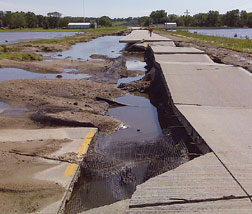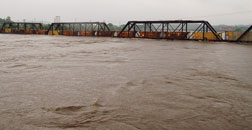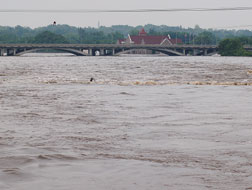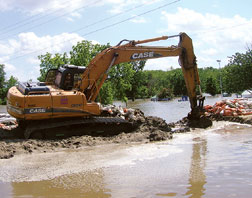...a hole in a 72-in. corrugated metal pipe, rather than a drain-valve failure, as had been feared, Dooley says. The incident had raised significant alarm, with the Corps attempting to close the drain with concrete bridge sections as a temporary plug in case the valve had failed.
 IOWA Dot Rushing flood destroyed roads.
|
ASCE’s Mongan says the flooding makes clear the need for a national levee safety act. “We need to address levees everywhere. Someone made a statement at the recent Midwest Levee Conference that there are two kinds of levees in this country: those that have failed and those that are going to fail,” Mongan says. “We need to stop looking backward and stop blaming each other for what happened in the past. We need to look forward and find a way to deal with our infrastructure problems in this country, in a constructive, focused, coordinated manner.”
Rails, Roads and Bridges
Highway departments throughout the flood zone are assessing damage. W.N. “Nick” Marianos, a consulting engineer and a research professor at University of Missouri-Rolla’s Center for Infrastructure Engineering Studies, notes that “scour at the pier or abutment” is the primary cause of bridge failures. The six bridge maintenance teams of Iowa’s Dept. of Transportation have inspected more than 100 bridges for scour with sonar, says David Claman, a preliminary bridge engineer with Iowa DOT’s office of bridges and structures. Five have “some significant scour, but not enough to warrant closure,” Claman says, adding, “Most of our closures are due to road damage.”
 Crandic Rail Co
|
 Crandic Rail Co Bridge over Iowa’s Cedar River (top) was loaded for a fast drop to protect nearby bridge.
|
Marianos says access-roadway flooding is a common bridge problem in the Midwest. Another problem is the buildup of drift at bridge piers, creating a dam effect that can lead to high loads.
OCCI Inc., a heavy-construction contractor in Fulton, Mo., spent days using an excavator to pluck debris from a temporary bridge the company had built in the middle of the Des Moines River to aid construction of the Katie Shelley Bridge for Union Pacific Railroad. “We had designed the bridge for the previous high record from 1993, and it went 6 ft over,” says Tom Smith, president. “We walk 300-ton cranes over it, so it is a big temporary bridge. But you have 4-ft dia., 50-ft-long trees that rip out of the banks, and if they pile up on the bridge, it becomes a dam that probably won’t survive.”
Missouri DOT engineers were still waiting for waters to drop to assess their scour-critical bridges prior to reopening them to traffic, says Marisa Brown, community relations manager for the agency’s northeast district.
Iowa DOT’s Claman says the lessons learned in 1993 are paying dividends in 2008 with repaired bridges, but the decision made then to stick to the 50-year-flood design standards instead of upgrading “was made on a cost-benefit ratio compared to frequency of flooding.” It is too soon to say if that calculation will be adjusted.
Smiling in Des Moines
But as the waters recede, officials in Des Moines, Iowa, are looking back with satisfaction at a choice they made after the floods of 1993 to not wait for federal money and largely self-fund their own levee improvements. Fifteen years and $70 million later, the city was spared significant damage, while other cities along the floodplains face months of clean up and billions of dollars of pain.
After the 1993 flood devastated downtown Des Moines, “there was a real community sense that a comprehensive plan was needed,” says William Stowe, director of public works. That year, the city hired consulting engineer Stanley Consultants, Muscatine, Iowa, to develop a master plan, which the city began implementing immediately. Stowe says the key was acceptance that federal funding was undependable and that the city would have to bear most of the cost.
 Rick Vaughn/City Of Des Moines Almost all of Des Moines’ protections held, but a weak spot took its toll.
|
The total cost to date is $70 million roughly 75% local funding and the rest federal. Ninety percent of the local money came from general obligation bonds, says Stowe. The rest came from revenue bonds issued by a city stormwater utility authority. Federal funds were cobbled together from various federal agencies and programs secured with the assistance of Iowa’s congressional delegation. Virtually none of the money came from traditional levee-funding streams.
Over the years, contracts were prioritized and let by the city based on a cost-benefit analysis. The city then managed the work, with technical assistance from the Corps’ Rock Island District. The bulk of the actual levee improvements raising levees 3 ft or more were performed in the mid-1990s, says Stowe. The work consisted of many small projects under $4 million. Other contracts included pumping systems, major stormwater improvements and reconfiguring railroad cuts in the downtown area.
One levee on the Des Moines River opposite downtown did fail, causing minor flooding in a residential area. The city has issued a $500,000 emergency contract for repair. Officials were aware the levee was weak in that area, and the Corps received approval last year to rebuild it, but Congress has yet to appropriate funds.
Stowe says that while the $50 million local investment to upgrade city levees might seem steep, it compares well with the alternative other cities experienced. Preliminary fire-department estimates put property damage in Cedar Rapids, for example, at $750 million.



Post a comment to this article
Report Abusive Comment